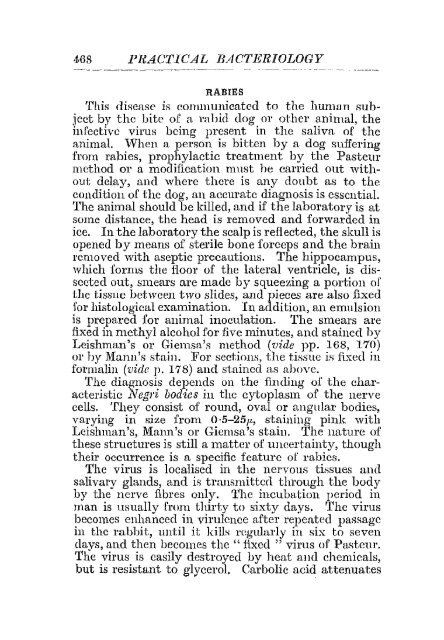AGf~ICULTURAL RESEARCH, PUSA.
AGf~ICULTURAL RESEARCH, PUSA.
AGf~ICULTURAL RESEARCH, PUSA.
Create successful ePaper yourself
Turn your PDF publications into a flip-book with our unique Google optimized e-Paper software.
4,68 PllACTICAL BACTERIOLOGY<br />
RABIES<br />
This disease is communicated to the human subject<br />
by the bite of a rahid dog or other animal, the<br />
infective virus being present in the saliva of the<br />
animal. When a person is bitten by a dog suffering<br />
from rabies, prophylactic treatment by the Pasteur<br />
method or a modifi.cation must he carried out without<br />
delay, and where there is any doubt as to the<br />
condition of the dog, an accurate diagnosis is essential.<br />
The animal should be killed, and if the laboratory is at<br />
some distance, the head is removed and forwarded in<br />
ice. In the laboratory the scalp is reflected, the skull is<br />
opened by means of sterile bone forceps and the brain<br />
removed with aseptic precautions. The hippocampus,<br />
which forms the Hoor of the lateral ventricle, is dissected<br />
out, smears are made by squeezing a portion of'<br />
the tissue between two slides, and pieces are also fixed<br />
for histological examination. In addition, an emulsion<br />
is prepared for animal inoculation. The smears are<br />
fixed in methyl alcohol for five minutes, and stained by<br />
Leishman's or Giemsa's method (vide pp. 168, 170)<br />
or by Mann's stain. For sections, the tissue is fixed in<br />
formalin (vide p. 178) and stained as above.<br />
The diagnosis depends on the finding of the characteristic<br />
Negri bodies in the cytoplasm of the nerve<br />
cells. They consist of round, oval or anglllar bodies,<br />
varying in size from O·5-25fL, staining' pink with<br />
Leishman's, Mann's or Giemsa's staiu. The nature of<br />
these structures is still a matter of ullcertainty, though<br />
their occurrence is a specific feature of ra.bics.<br />
The virus is localised in the nervous tissues and<br />
salivary glands, and is transmitted through the body<br />
by the nerve fibres only. -:rhc incubation period in<br />
man is usually from thirty to sixty days. 'rhe virus<br />
becomes enhanced in virulence after repeated passage<br />
in the rabbit, until it kills regularly ill six to seven<br />
clays, and then becomes the" ii.xed " virus of PasteuI'.<br />
The virus is easily destroyed by heat alld chemicals,<br />
but is resistant to glycerol. Carbolic acid attenuates

















